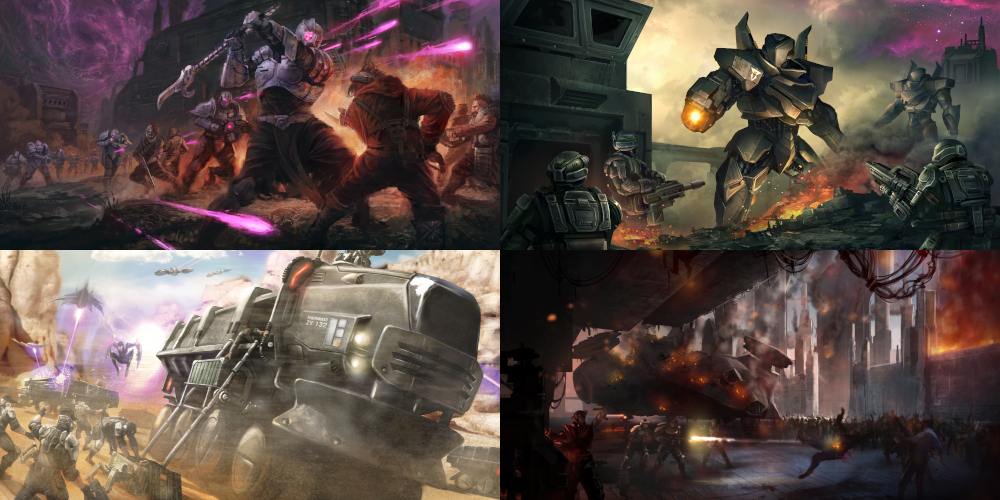Background Fiction - The Terraforming Process
Posted on Saturday Oct 08, 2016 at 06:00pm in Fiction
The Epirian Foundation is most famous for the variety of robots it employs, but the vast organisation made its fortune in the business of finding and cultivating new worlds. There are six stages to the terraforming process that the Epirian Foundation uses to take a planet from a barren wasteland to a verdant paradise. Taking a planet all the way from stage 1 to stage 6 can take thousands of years and huge investments. Frequently a planet is taken to stage 4 and the process is halted, for the cost of reaching garden world status is not deemed worthwhile for all but the richest or geographically blessed planets.
The six stages are:
- In stage one, a planet is barren, inhospitable and even overtly hostile to human occupation, due to extreme temperatures, atmospheric conditions, weather or seismologica phenomena. Even colonists in armoured vehicles or space suits are not safe. The goal of stage one terraforming is to stabilise the world, removing or mitigating the biggest threats to survival so that the terraforming process can begin in earnest. Stage one is dangerous, risky work and can take hundreds or even thousands of years, and in many cases might be too expensive to complete.
- In stage two, the planet is still unsuitable for sustaining life, but is no longer dangerous on a day to day basis. The next phase of terraforming is about removing big impediments to cultivating a viable habitat, such as the removal of toxic materials, protection against cosmic rays and the beginnings of atmospheric tweaking to provide breathable air and survivable temperatures. By the end of stage two, a colonist might be able to survive unprotected for a few minutes, but life still remains under protective domes. The transition between stage 2 and stage 3 typically begins the true colonisation age, as settlers flock to the world in search of their fortunes.
- A stage 3 world is marginally habitable. There might be a thin atmosphere that requires rebreathers, or substantial areas of the planet might be too hot or too cold to survive for more than a few hours. The third stage aims to begin moving more of the world's surface to a habitable state through atmospheric processing, temperature control using greenhouse gases or space-based mirrors, the seeding of a water cycle using comets of ice and the introduction of thousands of variants of nanoorganism that digest the soil or purify the air. It is at stage 3 that colonists begin to settle the planet in earnest, and much of the resource extraction is also performed at this stage. The planet of Zycanthus is around halfway through stage 3 of the terraforming process.
- Stage four begins to move a planet from a marginal world into a more comfortable home for humanity. The air is close to human-standard by now, and extremes of temperature are limited to the poles and equator. Following purification of planetside bodies of water or the introduction of water from ice comets, a truly self-sufficient ecosystem is cultivated, and agriculture moves from a desperate struggle against the elements to a profitable enterprise. Cities grow and the world ceases to be considered a backwater, sustaining a bustling economy and trade network with nearby planets.
- Stage five is where a world truly becomes a desirable place to live. Most of the planet is fertile and verdant, although differences in temperature and ecosystem can still vary widely depending on latitude and longitude. Agriculture is by now a key export, and tourism may even become a factor as outsiders flock to experience the natural world that has been created. Extraction of resources begins to be limited by environmental constraints, as a world of this quality is too rare and costs too much to be sullied by mining and industry.
- Stage six is a status achieved by relatively few planets across the Spiral Arm. Garden worlds or paradises, as they are often known, are blessed by fortunate geography or huge expense to be close to perfect for sustaining human life. Ecologies thrive, with vibrant habitats teeming with plant and animal life. Living on such a world becomes a status symbol in itself, and the rich and powerful flock to holiday in its lush forests and shining beaches. There is no greater prize than a garden world, and their loss to the Maelstrom is viewed as more tragic than almost anything else.
The processes and methodologies of terraforming vary widely between different human and alien cultures, and even within the varying franchises of the Epirian Foundation. The complexities of the process mean that each planet must be treated in a bespoke manner, with the terraforming tools used tailored to maximise the world's strengths and mitigate its weaknesses. When a world blessed with a few of the former but none of the latter is found, the battles to control it can be fiercer than any other.
Tags: epirian fiction terraforming
